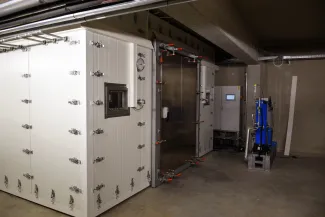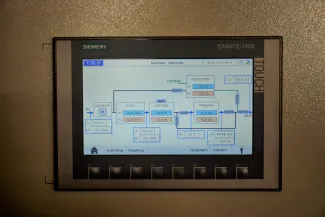A reference lab for indoor air quality
Last summer, VITO took its brand-new testing room for indoor air quality into use. We will start with several industrial customers who want to test their air purifiers. Now we are appreciating healthy and comfortable indoor air more and more, and there is new federal legislation too, these devices are rapidly becoming popular. But in VITO’s unique testing room, plenty more tests can be carried out. For example, how unpleasant odours can be avoided and remedied in a healthy and environmentally friendly way.

VITO’s new testing room for indoor air quality measures thirty cubic metres at the Health Hub site in Mol, where the air quality measurement team is based. There is a reason why we are expressing the size of the room – which is on the basement floor – in volume. The air refreshment level for the room, which can easily be altered, is also expressed as such. Fresh air is supplied to the testing room through stainless steel tubes, deliberately ‘contaminated’ with chemical substances or particles through a grid with small openings. This means the air supplied is neatly distributed homogeneously in the room. Afterwards, for example, an air purifier can do its work, and based on a measurement of the outgoing air, the appliance’s efficiency can be investigated.
Adequate management
The importance of good indoor air quality, both in public buildings and in any room in a house, has grown in recent years. The corona pandemic, in which we learned to monitor indoor air quality continuously using CO2 measurements, has certainly made a major contribution to this. If the CO2 value is too high, the window is often opened now – a traditional, but effective way of refreshing the air. But in several cases, this remains insufficient. Certainly in large spaces where many people come together, adequate management of the indoor air quality is needed. ‘Limiting contamination sources is core, and ventilation can supplement that,’ says Jeroen Van Deun from VITO. ‘If this is insufficient, then it might be possible to resolve it with an air purification system.’
In 2024, new (federal) ventilation legislation will be applied in Belgium on indoor air quality in public buildings (in the catering, sports and events sector). This should ensure in the coming years that people can meet each other in public spaces where the indoor air quality is being monitored. The operator will use a label to inform visitors of how effective the ventilation and any air purification is in the building.
The federal government is also working on a strategy for including air purification as a supplement to, for example, mechanical ventilation. One question that arises there is: how will the contribution of an air purification system in an enclosed space be traded off against the supply of fresh outdoor air? Today, there are already plenty of air purifiers on the market – large and small – but there are no stringent standards. Van Deun: ‘Standards are presently still limited to the clean air delivery rate (CADR), as it’s known, which tells you more or less how quickly an appliance can refresh a particular quantity of air. Moreover, a range of protocols exist for determining this, and further to that, not all the provisions of the CADR are handled by independent laboratories. Finally, often no account is taken of the actual impact on the overall indoor air quality. So we can now investigate that in our new testing room, which can also be viewed as a reference lab.’

Real-life scenarios
The VITO testing room is unique in Belgium. It was built by a West Flanders company that specialises in the construction of modular units. ‘You could compare our testing room with a clean room, although an improved version,’ Van Deun continues. ‘Not only is it completely free of dust, the materials from which it was constructed produce no volatile organic substances either, known as VOCs.’ Furthermore, the room has a high air density and is surrounded by a thermally isolating ‘cage’ that allows for the indoor parameters to be carefully controlled, such as temperature and air moisture. Finally, the unique nature can also be found in the finishing by the VITO experts. ‘We’ve provided some extra infrastructure ourselves, which makes our testing room a state-of-the-art facility.’
Reallife scenarios are simulated in the testing room, such as a living room, but also an office space, whether or not with people. By adding some furniture or carrying out activities in the room, the impact of specific scenarios on air quality can then be investigated, as well as the impact of air purifiers or other systems on this. The VITO researchers can also deliberately disseminate substances in the room, such as VOCs, but they could just as well be biological particles, such as viral particles. Van Deun: ‘We’ll obviously be carrying out corona-related research as well, although we will be working with harmless viruses that simulate the coronavirus.’
For now, the VITO air quality experts have no shortage of work. The testing room is already fully booked for the next few months. ‘We will start with several industrial customers who want to test their air purifiers. For clarity: the VITO experts will carry out those tests,’ says Van Deun. In addition, some further research is planned, for example into the prevention and combatting of unpleasant odours at home, using healthy and environmentally friendly methods – this is the core of Catalisti’s Odoretion project. Other research may be directed at larger facilities, which could also be used to purify the air in cattle stables, for example.



